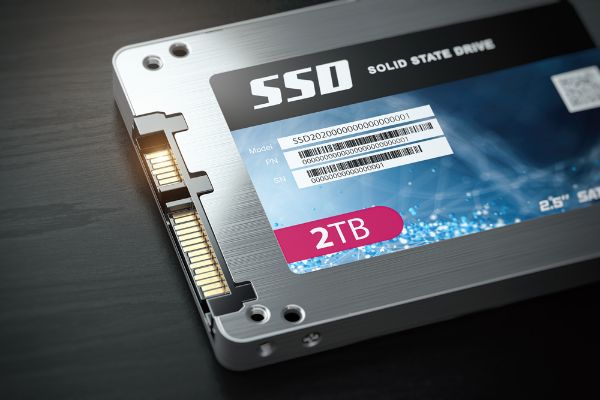Disclaimer: This post may contain affiliate links, meaning we get a small commission if you make a purchase through our links, at no cost to you. For more information, please visit our Disclaimer Page.
Solid-state drives are the companion to the typical computer hard drives with which readers may be familiar already. In fact, it isn’t uncommon to refer to both of these components as just hard drives, and tech enthusiasts may make distinctions between each one as they decide which drives are best for different applications or PC builds.
Both HDDs and SSDs are storage devices, but how they store information are different. Typical hard drives are mechanical, and solid-state ones use flash memory and have no moving parts. There are some other factors that set these things apart from each other as well, such as weight and noise reduction, speed, and size considerations.
Because of these factors, some users might wonder if SSDs have a memory cache of their own. We will tackle this subject in our article below. As we dig deeper into what a cache is and how it works, we’ll also explain how there might be different types of caches.
Furthermore, we will address the relative importance of caches as they relate to solid-state drives, and we’ll place a particular focus on whether SSD caches have any positive impact on resource-intensive tasks like gaming.
Table of Contents
Do SSDs Have a Cache?
Before we get into the specifics of caching as it relates to SSDs, we need to talk a bit about what a memory cache is and how it works. Cache memory is a chip-based component that stores data for you to access much more quickly than if your computer just looked for it on the hard drive itself.
With that description, you may wonder if cache memory is just another name for random-access memory. These two things are related, but they are not the same.
In most cases, cache memory will be many times faster than RAM memory. RAM memory is further away from the central processing unit than its cache counterpart, and that means that it will take longer for RAM to find and access data.
The computer will look for temporarily stored data in the cache first. If it does not find it there, then it may proceed to check the RAM for the same information. Cache data is somewhat automatic, and it can depend on what bits of data you access repeatedly.
Once you access the same data points over and over again, the computer learns what things you might need access to quickly, and much of this information will then be stored in the cache.
You may have heard about clearing the cache as part of the routine maintenance of your computer, and doing this removes some temporary files that could be clogging up or slowing down your system.
Cache memory is limited and rather expensive for its storage size, which is why we don’t store all information on the cache file for quick access.
With all of that said, cache memory for a solid-state drive can get a bit complex. SSDs can call up files and information very quickly on their own, leaving some users to wonder why such drives might have cache memory at all.
While it is true that, sometimes a solid-state drive can read and call up information almost as fast as you might write repeated data to the cache, the nature of how flash memory in such a drive works can lend itself to caching.
Mostly, a cache like DRAM memory on a solid-state drive is useful for some bookkeeping tasks and arranging information. With solid-state drives, one cannot write data to the drive in single bytes. Whole blocks of data must be erased or overwritten with new blocks of data.
Although this is a relatively quick process for most SSDs, cache memory helps to expedite everything by caching requests from the computer to erase and write to blocks of memory. The drive may use the cache to queue several of these requests that it can then complete in a single job.
How Does SSD Caching Work?
Solid-state drive caching can refer to two main things, both of them try to fulfill different purposes. The first way caching works is by doing what we mentioned above, and that is simply storing data in a place where the drive can find, read, and bring it to you very quickly.
There are a few ways the solid-state drive might do this, and we will go over the different methods at its disposal in a later section.
The second way SSD caching might work is somewhat different from the typical tasks that we’ve touched on already. As a method itself, SSD caching usually refers to a specific process that uses a solid-state drive as a cache itself.
Oftentimes, this can work in conjunction with a more typical hard drive. If you are a single user trying to get the most out of a consumer-grade device, SSD caching could be one of the most cost-effective options available to you.
This stands in opposition to the solid-state drive itself, however. If you are already using an SSD as your primary means of storage, you might not benefit from SSD caching as a companion data storage option to your hard drive.
If you use a solid-state drive as a cache by itself, it can speed up your boot and load times tremendously. The goal here would be to improve overall system performance.
How the different drives do this can depend on a few factors, but most users should see noticeable improvements immediately. Caching puts all files in a sort of hierarchy that sends the most important or accessed ones to the fastest level, moving different files to different levels below that as needed.
Having an SSD cache in place gives the computer an extra place to look for data that the user wants to access frequently. Having this new space for temporary file storage can speed up operations, primarily because an SSD cache will be much faster than a typical hard drive one.
Furthermore, it provides a lot more space to store cached files in a way that can get to the CPU quickly.
What Are the Different Types of SSD Cache?
There are three main types of SSD cache:
1. Write-around
Write-around caching writes data directly to the primary device itself, and it does so by first going past the cache. This same data will go to the cache eventually, but this makes write-around a somewhat slower process, since it is going past the cache where the data is stored for efficiency.
The advantage here is that the data written to the drive in this way won’t go back to the cache until the computer recognizes that it is used frequently. This prevents irrelevant data from clogging up the cache.
2. Write-back
Write-back puts data on the solid-state drive cache completely. Once done, it will then send a copy of that data to whatever primary storage device the computer is using.
If you need low latency, this is a good type of caching to use. It is meant to result in very fast operations both for the reading and writing of data. This is the fastest caching available, but it does pose some risk to the integrity of the data in the event of a power failure that could corrupt it.
3. Write-through
Write-through puts data on the SSD cache and the primary storage unit simultaneously. It is a common hybrid solution for many users.
Here, data is only available to the SSD cache once the write operation is fully done for both units. It may be the most common type of caching, although it is somewhat slower than the others.
How Important Is an SSD Cache?
The answer to this question depends on what you plan to do. For many large files, caching probably isn’t as important. This is because the cache will not store the files because of their size, or it will try to cache them one at a time.
Either of these will limit the usefulness of the caching system. However, for storing many smaller data files that you access regularly, SSD caching may be more beneficial to you.
Multiple smaller files are things that the system can queue to bring up very quickly, and even a few gigabytes of cached storage can handle lots of small files.
Does SSD Cache Matter for Gaming?
Yes and no. If you’re already running a game on the SSD itself, then you won’t be accessing the hard drive as much while the program is operational. This can limit the effectiveness of caching for gaming purposes.
Where you might see the most improvement is with load times for levels as you progress. However, actual performance in the game should not see much noticeable improvement.
Conclusion
A solid-state drive tends to be much faster than its mechanical partner by default, and the data stored there is something the computer should be able to access quite quickly. Caching can help with this process even further by adding many files that users need to access regularly.
The types of caching used might influence the overall speed and performance improvements you see, and there are some operations that may not benefit from caching. However, any single type of caching represents an extremely efficient way to access data, sometimes in a matter of a couple of seconds.


